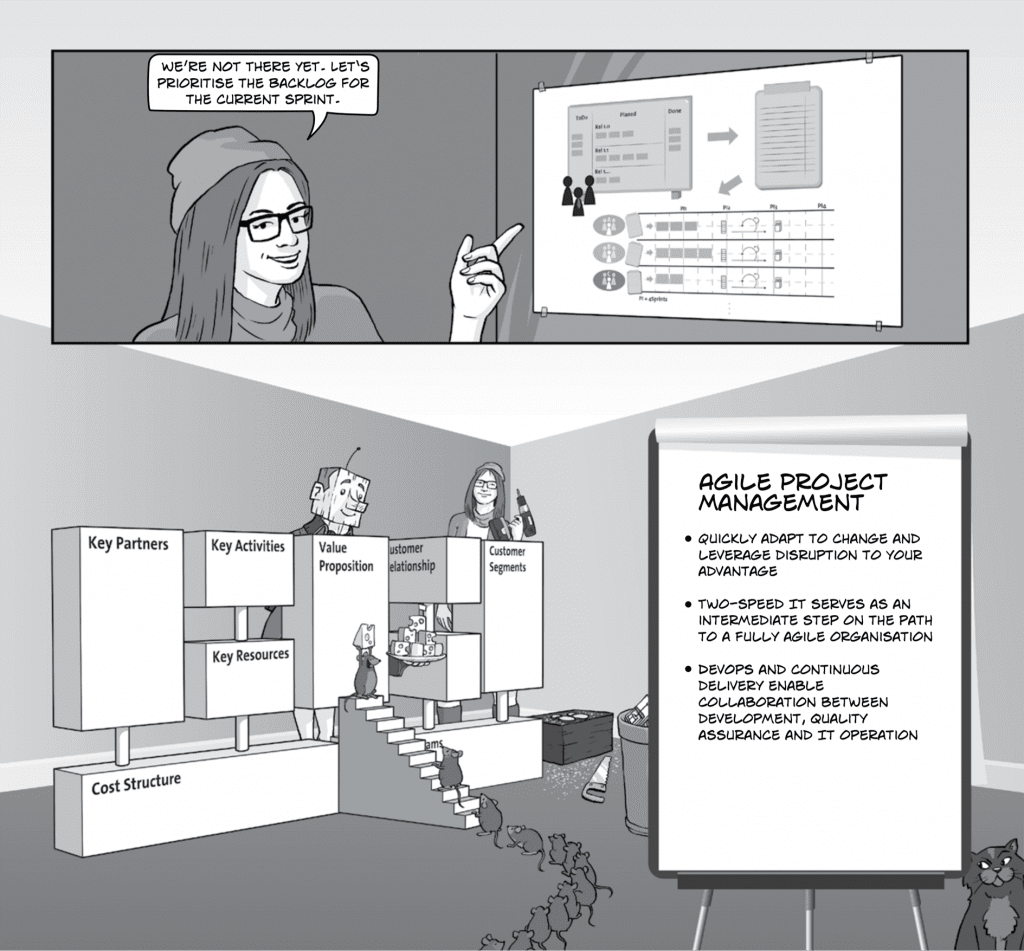Digitalisation is driving variability and changeability in business at a faster rate than ever before in history.
The hypothesis of a stable business environment with gradual technical innovation and foreseeable customer behaviour is no longer true. At this point, agile project management steps in. It supports highly productive development, despite continuously changing business needs, and helps to reach the goals of the digital vision.
Following lean and agile principles facilitates organisations to effectively reach these goals. Some important principles are as follows:
- Deliver early and on a regular basis while managing economic trade-off parameters such as risk, cost and delay for each solution.
- Manage uncertainty by not picking a single option early in the process, but instead by maintaining multiple design options.
- Short iterations support rapid customer feedback and fast learning cycles. Failing earlier means faster learning.
- Milestone evaluation based on working systems promises better understanding between customer and builder.
- Provide autonomy, mission and purpose to knowledge workers for a better motivation.
The Agile Manifesto was an important milestone in 2001. [1]
The manifesto combined several so-called ‘lightweight methods’ such as Scrum,[2] Dynamic Systems Development Method (DSDM), Extreme Programming (XP) and Crystal, which were ‘agile’ in the sense that they matched the spirit of the Agile Manifesto.
Agile software development defines a set of principles under which requirements and solutions grow through the collaborative power of self-organising cross-functional teams. It permits adaptive planning, evolutionary development, early delivery and continuous improvement, and it encourages rapid and flexible response to change.
Scrum, perhaps the best-known agile software development framework, is a lightweight framework designed to help small teams successfully develop complex products.
The previous sections discussed modelling techniques for digitalisation. In particular they describe the phases ‘Business Architecture’ and ‘Functional Architecture’. Those preparative phases are required as the frame in which agile projects can act independently, deliver value and can be integrated into the context of the enterprise. This requirement has also been reflected in more recent agile frameworks that address enterprise-level activities, for example, Scaled Agile Framework [3],[4] (SAFe) and Large-Scale Scrum [5],[6] (LeSS). Comparing SAFe with LeSS, both frameworks are based on Scrum at the team level and both have a selection of agile and lean practices for agile scaling.
SAFe provides quite a detailed process layer on top of Scrum to coordinate the complex flows and provide predictability. It implements new processes and introduces agile principles. SAFe is a relatively complex framework for embedding agile processes into large organisations and is more easily understood by the traditional operative management.
LeSS scales up Scrum teamwork without adding layers or processes. It simplifies the organisation radically and is very flexible. It is based on the concept of self-organising teams. In a LeSS organisation, for example, feature teams deliver business components, cross-functional teams take care of technical coordination and the product owner team works with the market. Managers become coaches.
However, transforming an existing organisation into an agile organisation is a tremendous task taking several years.
Many organisations take an intermediary step known as ‘two-speed IT’[7],[8] (also known as ‘bimodal IT’), which was invented around 2012. A two-speed IT architecture enables companies to develop their customer-facing applications at high speed while decoupling legacy systems for which release cycles of new functionality remain at a much slower pace using traditional development styles.
Two-speed IT is a valuable intermediate step on the path to an agile organisation. A new IT architecture fully based on agile principles can facilitate organisations to develop software at full speed without separating the back end from the front end. Younger companies, like Google, Amazon, Facebook and Spotify, demonstrate this impressively.
While the agile transformation focuses more on the earlier phases of a development life cycle, it is also important to look at the later phases. It is important to establish an environment where the releasing of applications becomes more reliable, faster and more frequent. In traditional functionally separated organisations, there is rarely cross-departmental integration of development and quality assurance (QA) with IT operations. DevOps and continuous delivery concepts help to enable this integration and speed up release.
Continuous delivery and DevOps are two different concepts with common goals. DevOps has a broader scope and is about organisational change, the collaboration between teams (development, operations, QA) and the automation of the processes in software delivery. Continuous delivery is an approach to automating delivery inherently; it focuses on bringing together different delivery processes and executing them more quickly and more frequently.
Implementing these lean and agile principles in the development organisation enables the enterprise to quickly adapt to change.
Evolutionary development, early releases and continuous improvement deliver a constant flow of business value while maintaining the highest quality levels.
To drive and apply agile transformation to the enterprise, an appropriate agile scaling framework is directly implemented or an intermediary step with two-speed IT is carried out. Embedding development departments into QA and IT operation departments results in a high-performing, exceedingly competitive digital enterprise, leveraging disruption to its advantage.
_____
[1] Beck, K., Grenning, J., Martin, R. C., et al.: ‘Manifesto for Agile Software Development’, Agile Alliance, 2001.
[2] Schwaber, K., Beedle, M.: ‘Agile Software Development with Scrum’, Pearson, 2001.
[3] Leffingwell, D.: ‘SAFe® 4.0 Reference Guide: Scaled Agile Framework® for Lean Software and Systems Engineering’, Addison Wesley, 2016.
[4] Scaled Agile Inc.: ‘SAFe’, Scaled Agile Inc., 2017.
[5] Larman, C., Vodde, B.: ‘Large-Scale Scrum: More with LeSS’, Addison Wesley, 2016.
[6] Larman, C., Vodde, B.: ‘LeSS’, The LeSS Company B.V., 2014.
[7] Gartner: ‘Bimodal’, Gartner, 2012.
[8] Gourevitch, A., Rehberg, B., Bobier, J. F.: ‘Two-Speed IT: A Linchpin for Success in a Digitized World’, BCG, 2012.



